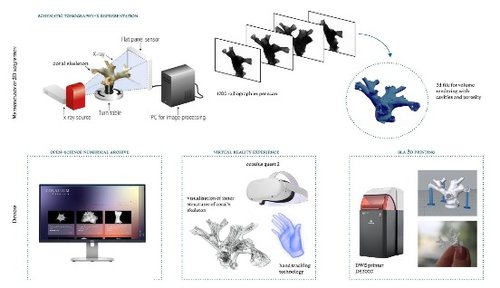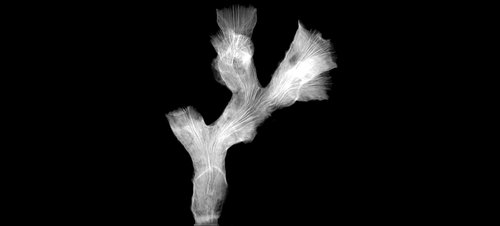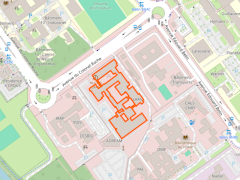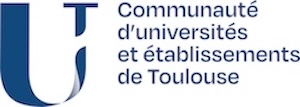Design and Art in Sciences
A Transdisciplinary Approach for Open Science
Main researcher : Elise Rigot
Associated researchers : Christophe Vieu, Laurent Malaquin, Bastien Venzac
Several projects are implemented to bring together Design sciences and Engineering sciences, with a strong focus on the scientific activities of the team. The objective of this transdisciplinary activity is to question our scientific practices and our ways of producing scientific knowledge at the crucial moment of humanity : the Anthropocene. Indeed, this new condition of existence invites us to renew our ways of doing science. We hypothesize that design has the ability to make science visible and accessible while it is being constructed by the researchers. In doing so, it contributes to the dissemination of a form of “sensitive” knowledge which beyond its scientific and technical aspects, exists and holds meaning for others.
The methodology followed is that of research-creation in design. A large-scale project called "Corallum Fabrica" illustrates this approach. In collaboration with marine biology researchers and designers, we are studying how 3D technologies (virtual reality, multi-scale and multi-material 3D printing, X-ray tomography) can renew the study of coral in an open, innovative, and participatory way. The result of the project takes the form of an open digital archive that brings together the fine structure of the mineral skeletons of coral species. The ambition of the project is to preserve the common cultural heritage embedded in coral's skeleton art of building.

Schematic representation of advanced 3D technologies applied to coral skeletons structures for generating open science knowledge and common memory with x-ray tomography, 3D rendering, VR devices and 3D StereoLithography printing technologies.
Each polyp (animal of the coral) occupies a place in one corallite of the whole structural biomineral reef. Each corallite has a specific architecture exhibiting details at the micrometric scale specific of the coral species. The 3D constructed archive displays in open-science the biodiversity of these animal constructions. We have addressed this challenge by using x-ray micro-tomography (EasyTom XL) to image and numerically encode the 3D architectures, inner cavities, porosities, and micro-structures of coral skeletons collected from National Museum of Natural History in Paris and other collections. A dedicated Virtual Reality Tool (oculus quest 2, Unity software) with hand tracking technology has been designed for public dissemination. It allows an immersion inside the details of the micro-structures and the discovery of a large panel of morphologies which characterize the different species. Moreover, we reproduced (1-100X) fantoms of these structures by 3D printing methods involving stereolithography and large-scale printing by clay extrusion. The dual impact of the project is both cultural and scientific. The virtual reality experience and the sculptures is used for scientific mediation and public outreach in museums, schools and sensibilization events. The open-access archive is used by the scientific community interested in coral mineralization and growth modelling.

Example of an X-Ray image of a skeleton of a deep coral species Euphyllia glabrescens
We also have experienced another methodology at the Art/Science interface by hosting a group of Artists from Canada and France in residence inside our team and laboratory. In this approach the objective is essentially reflexive and not simply oriented towards the artistic production itself. Because many research activities of our team in engineering sciences contribute to blurring the boundaries between natural and artificial systems through for example the notion of organ on chip, we are collectively engaged in ethical reflection and, through various case studies we question how these bodies of knowledge and technologies align with the perspective of a new humanism that breaks away from the anthropocentrism of modernity. We strongly believe that this complex reflection requires dialogue with other researcher-creators, such as artists capable to see and imagine these issues with a new angle, new dimensions, new methodologies and different forms of production. In contrast to other classical residences in research lab, the idea is not to “use” the artists for disseminating complex scientific results in a scientific mediation perspective neither for the artists to grasp inside the lab new techniques of fabrication for their own artistic projects, but really to co-construct between researchers and artists common productions capable to feed an ethical reflection about the research activities of the team.
Productions:
- Corallum fabrica archive : https://corallumfabrica.laas.fr/3dlibrary
- Elise Rigot et Christophe Vieu. « Corallum fabrica : une archive vivante comme média d'encapacitation pour la recherche scientifique », 2024, in Communication & design, créations collectives (dir. Lionel Lavarec), Hermès La Revue,CNRS éditions, collection Essentiel 12, https://laas.hal.science/hal-04469439v1
- Engineering Materials for Regenerative Medicine:A time issue, Elise Rigot and Christophe Vieu, 2021, https://laas.hal.science/hal-03319094v2
- Le design pour le(s) vivant(s) : appréhender sans optimiser, Elise Rigot, Sciences du Design, 2019, 2019/02 (10), pp.42-50, https://laas.hal.science/hal-02892495v1
- Advanced 3D technologies applied to coral skeletons structures for generating an open science archive, Elise Rigot , Denis Tribouillois , Guillaume Barbareau , Julie Foncy , Jean-Marc Larré , Christophe Zanon, Julien Libourel, M. Castelin, I. Domart-Coulon, Paul Duru, Lorenzo Bramanti, Franck Lartaud , Serge Planes, Laurent Malaquin , Christophe Vieu, International Coral Reef Symposium (ICRS 2022), Christian R Voolstra, Jul 2022, Bremen (DE), Germany, https://laas.hal.science/hal-04473711v1
Collaborations :
Laboratoire Ecogéochimie et Environnements Benthiques (LECOB), Muséum National d’Histoire Naturelle (MNHN), Centre de Recherches Insulaires et Observatoire de l'Environnement (CRIOBE), Institut de Mécanique des Fluides de Toulouse (IMFT), Réseau Hexagram Canada (https://hexagram.ca/en/), Association Passerelle Art-Science-Technologie Toulouse, LLA-Créatis Toulouse.
Fundings:
Fundation Dassault Systems, 3D Corail Project 2021-2024













